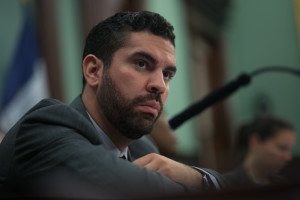
New York City Council Member Rafael Espinal. Image credit: NYCC/William Alatriste
The modified East New York Rezoning includes such deep levels of affordability that Council Members referred to the rezoning plan as a “unicorn,” though all hope to use it as an example for future rezonings. On April 14, 2016, the City Council Subcommittee on Zoning and Franchises and Committee on Land Use held back-to-back meetings on the Department of City Planning’s East New York Rezoning Plan, which would affect the greater East New York area of Brooklyn. The proposed rezoning would make East New York the first of 15 neighborhoods to be rezoned under Mayor Bill de Blasio’s Housing New York plan.
The East New York Rezoning Plan is comprised of four separate zoning text amendment applications, which are now under Council consideration as land use item-numbers 341, 342, 343, and 344. The proposed rezoning began its journey through the public review process in September of 2015 as one of the three major initiatives proposed by Mayor de Blasio under his Housing New York plan. On March 7, 2016, the City Council held a public hearing on the proposed rezoning, where questions and comments made by City Council Member Rafael Espinal, the East New York representative, indicated the proposed rezoning needed much improvement before it would be approved by the City Council.
At the Subcommittee on Zoning and Franchises meeting, Council Member Espinal explained the modifications that have been made to the rezoning plan since the March 7th hearing. One of the most important modifications had been made to item number 344, which contains the provisions on affordability levels. Item number 344 has been amended to provide for significantly deeper levels of affordability—20 percent of new residential units must be reserved for families earning up to 40 percent of the area median income, or AMI, which equates to income levels up to $32,000 per year. The modification was made to help existing East New York residents stay in their neighborhood by buffering the displacement effect caused by new, high-end development.
In addition to the deep levels of affordability, the proposed rezoning includes a commitment by the City to invest $267 million in capital improvements, which includes a $12 million commitment to implement a pilot program aimed at legalizing rentable basement apartments in single-family homes and a $41 million commitment to improve safety conditions on Atlantic Avenue. The funding will also be used to revitalize parks, create a down-payment homeowner assistance program, implement a homeowner help desk, and create an economic development plan in the East New York Industrial Business Zone, which will include a Workforce1 Center to connect local resident-jobseekers to open positions. Further, item number 341 has been amended to remove Brooklyn’s Arlington Village neighborhood from the proposed rezoning in order to preserve its contextual nature.
At the Land Use Committee meeting, Council Member David Greenfield pointed out one of the new provisions added to the proposed rezoning, which would provide East New York’s displaced, homeless population with 500 LINC—“Living in Communities”—vouchers. LINC is a City program that seeks to move homeless families out of shelters and into affordable housing, paid for by the City of New York. Council Member Greenfield noted that this is the first time the City has committed to providing LINC vouchers as part of a proposed rezoning to combat displacement.
According to Council Member Greenfield, the East New York Rezoning Plan is proof that MIH is just the floor for affordability levels. “Today, quite frankly, you have seen the ceiling,” he said.
Council Member Antonio Reynoso praised the proposed rezoning’s ability to reach such deep levels of affordability. “I’ve never seen affordability this low or this much in any of the City-owned units in New York,” he said.
The Subcommittee on Zoning and Franchises voted to approve the proposed rezoning with five Council Members in favor of the proposal, none opposed, and one abstention. Council Member Jumaane Williams originally abstained from voting, but later voted in favor of all four items at the Land Use Committee meeting.
The Land Use Committee voted to approve item numbers 341, 342, and 343 unanimously. Item number 344 was approved by the Committee with 18 Council Members in favor of the item, Council Member Inez Barron against it, and no abstentions. Council Member Barron’s main point of contention is that there will be rent-burdened residents within the geographic scope of the proposed redevelopment who will not benefit from the plan, such as the 25 percent of the residents who earn below $15,000 per year.
City Council: LU 0341-2016, 0342-2016, 0343-2016, 0344-2016 (Apr. 14, 2016).
By: Jessica Soultanian-Braunstein (Jessica is the CityLaw Fellow and a New York Law School Graduate, Class of 2015)


i was born in 1950 and lived in Brownsville till February, 1962.
Though affordable housing is essential, there must be strict screening and
behavior requirments for all tenants once they move in.
We all saw East New York become a disaster area during the 1970’s and we cannot let that happen again.
It seems that affordable housing is being overdone. Affordable is just a euphemism for low income projects, which often destroy neighborhoods. Though low income, does not imply low moral standards and poor behavior, we still must remain aware of who moves in.
Let us not have a repeat of the 1970’s. Gentrification is liberation!!!!